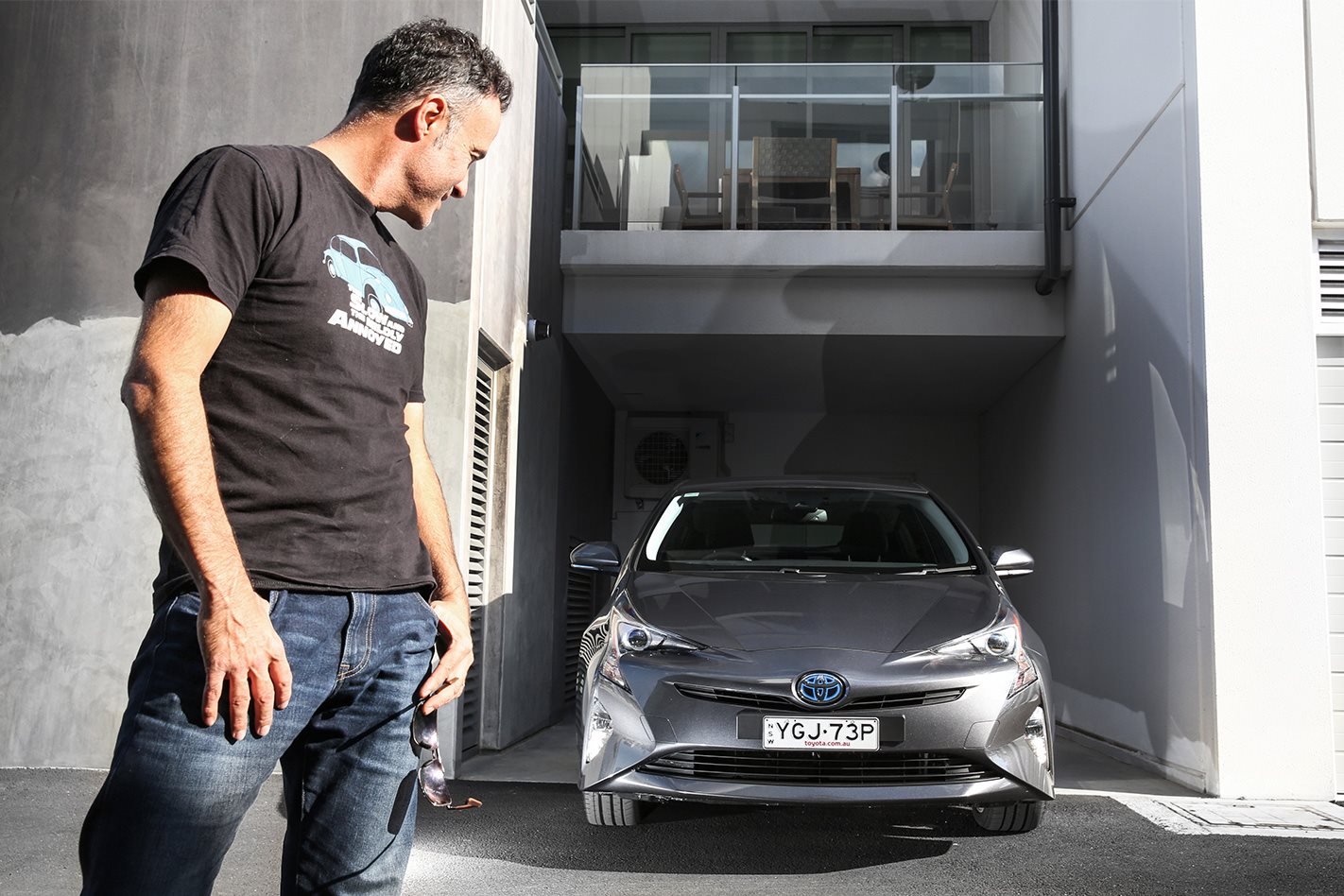
- Introduction: Real Revolution
- Update 1: Tour of Duty
- Update 2: Under the Cover of Piety
- Update 3: Conclusion
Introduction: Real Revolution
SOMETIMES fortune deals a hand that couldn’t seem more premeditated if fate itself was pulling the strings. Case in point – the latest Toyota Prius.
Launched early last year, only months after the Volkswagen Group’s diesel emissions cheating scandal has left every oil-burner literally under a cloud darker than the soot that purportedly spews from their stinking exhaust pipes, the fourth-gen petrol-electric hybrid has suddenly found itself standing as one of a handful of legitimate non pure-electric eco alternatives to normal petrol cars.
Additionally, the Prius was the first to receive the hotly anticipated Toyota New Generation Architecture (TNGA), which is set to underpin many models in the maker’s vast empire. Espousing lighter, stronger, quieter and more spacious engineering, with a switch to a pair of double wishbones after years of a torsion-beam rear suspension. It’s highly promising stuff.
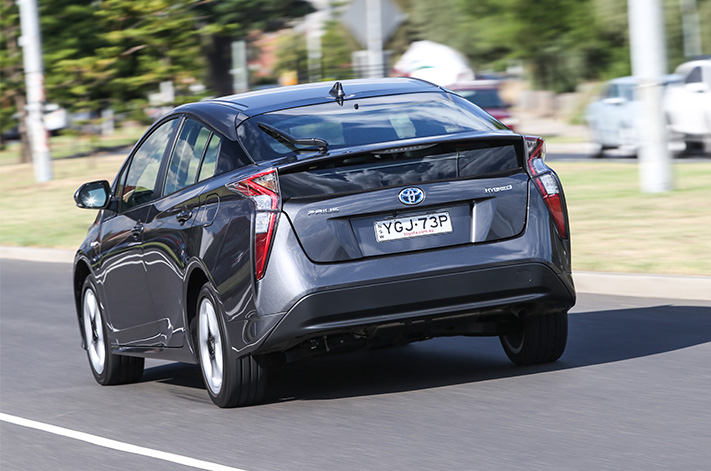
Finally, all that TNGA goodness provided an opportunity for the reborn hybrid icon to usher in some fresh design thinking inside and out, to further help it stand out as the green car of choice for the masses as we head towards an uncertain future. Like we said, it’s as if Toyota’s strategists couldn’t have timed the Mk4’s debut better.
But the best laid plans… more than 12 months on and the fourth Prius since October 2001 has yet to fire. And this is despite headline improvements like industry leading fuel economy (3.4L/100km is the official average), improved space and significantly more active safety gear, such as autonomous emergency braking, as part of higher standard specification levels that more than offset a $2500-plus price jump in the base version.
If you’re wondering why, consider seeing an ophthalmologist, because the Prius’ styling – while commendably aero at just 0.24Cd – is provocative at best, and a poke in the eye at worst. That insectoid snout would make Mothra squirm. We reckon it blinds people to the huge steps the series has made in terms of handling, body control, comfort and refinement.
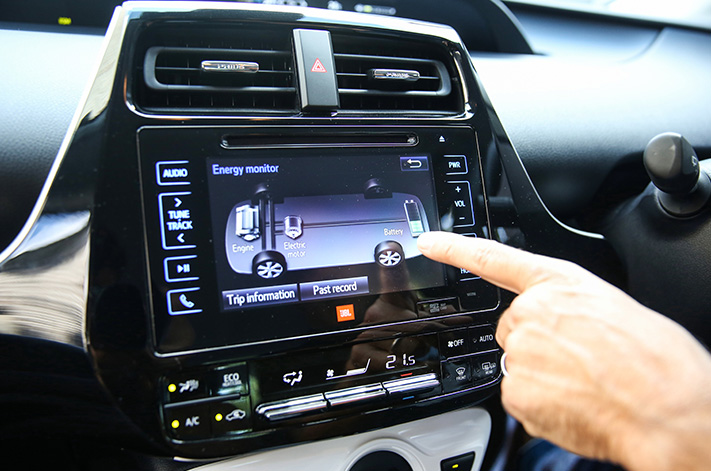
With previous iterations woefully devoid of steering feel and ride finesse, I vowed I’d never own one. That’s why I put my hand up for a long-term Mk4 after experiencing the range at the most recent round of COTY testing. In many ways, and despite the grotesque looks, the redesign represents one of 2016’s biggest improvers.
The three-month wait for our i-Tech to arrive from Japan was worthwhile. I chose Graphite metallic to help neutralise the challenging aesthetics, helped out by the attractive toy car-like 17-inch lightweight alloys that the upper-spec version brings (up from the tiny 15-inch items).
For an $8K premium, the i-Tech also nets satellite navigation, leather seats with electric driver’s side adjustment and heating elements for the front pair, digital radio, blind-spot monitoring and rear cross-traffic alert systems. That’s on top of the standard $35,690 Hybrid’s active cruise control with auto braking, lane-departure warning with steering-nudging input, auto high-beam, seven airbags, rear camera, keyless entry/start, head-up display, LED headlights, 10-speaker audio and full multimedia connectivity including a wireless charger for Android phones. Too bad I use another platform.
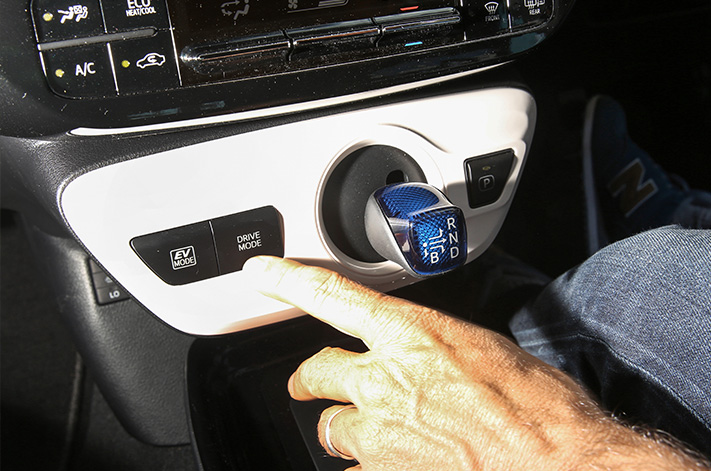
Oddball, low-Cd styling makes sense alongside sister the Mirai – one of the first commercial hydrogen fuel-cell cars.
In the first month of getting to know YGJ-73P, I am struck by how soft and cosseting the sumptuous front seats are, amused by the bisected rear window, annoyed by the foot-operated park brake (I’ve stopped using it in protest – I guess if it rolls into something the styling might improve), pleased by the build quality and delighted by the economy. Likewise, the performance is ample and ride nicely absorbent. However the steering is a tad too low-geared and feel-free while the brakes are too snatchy and wooden in feel – a typical Toyota hybrid trait. Still leagues ahead of before though.
So things are falling into place for the Prius. This should be interesting.
Update 1: Tour of Duty
Hybrids only work in the city, right? Actually, Byron is finding an unlikely grand tourer in the Prius.
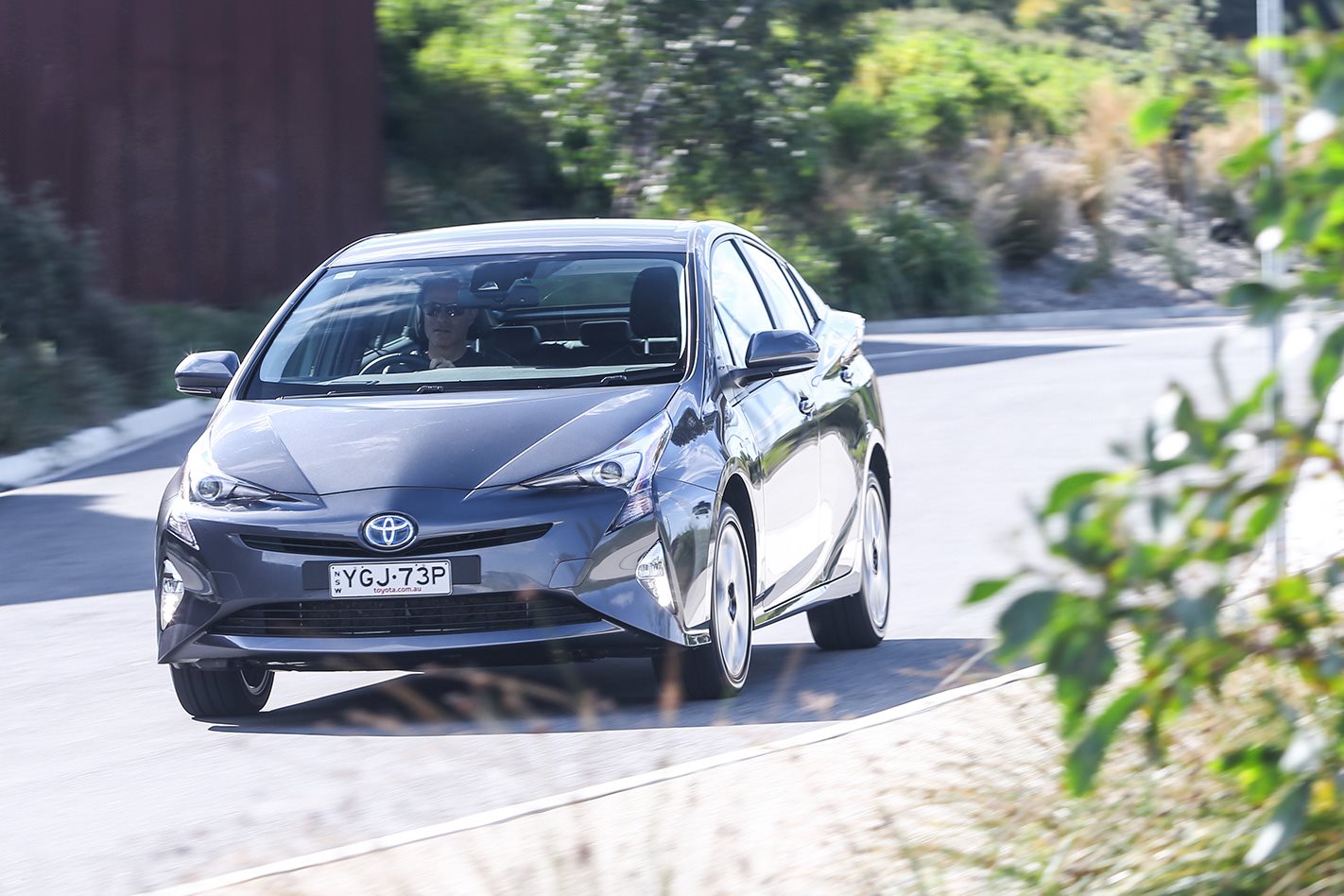
CONVENTIONAL wisdom dictates that series parallel petrol-electric hybrids like our Toyota Prius work best in inner-urban areas, where the battery-fed motor can more-often take over rather than merely assist the internal-combustion engine.
The thing is, we’re neither conventional nor particularly wise, as two sizeable intrastate trips, each taking in hundreds of kilometres, proved. One was work related. The other an extended public holiday getaway.
Our Prius’ 1.8-litre Atkinson Cycle four-cylinder engine (which refers to a combustion process that prioritises fuel economy over performance) was indeed working overtime, since there was only limited electric assistance during those long stints, mostly sitting at a safe 106km/h indicated, though occasionally hitting 118km/h, as one friendly policeman pointed out.
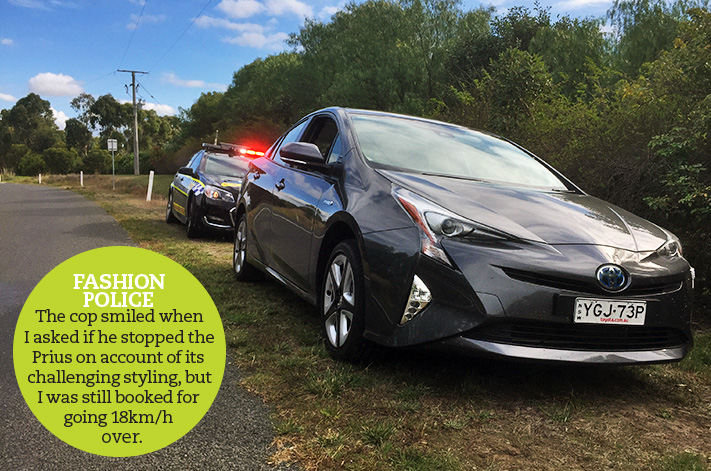
Besides copping a $300 fine and three points, the upshot was a jump in fuel consumption, from an outstanding 4.8 litres per 100km to a still-commendable 5.5L/100km average. Pretty good, actually, considering how packed-to-the-gunwales our ride has been this month.
Remarkably, the latest Toyota hybrid is more than agreeable out on the open highways. Much noise has been made about how much stronger and quieter the Mk4 Prius is over its raucous predecessors, but now there is evidence to back this up; even on the frugal-focused Bridgestone Turanza 215/45R17 tyres, the i-Tech feels planted and poised at speed in the wet. Road drone is subdued and wind rustle at cruise is pleasingly contained – helped no doubt by excellent aerodynamics.
More good news. The large front seats have a sumptuous look and feel, yet there is more than sufficient support even after a few hours.
Taller occupants will appreciate the extra amount of downward as well as rearward adjustment. And smart detailing abounds, including a passenger-side seat heater light so the driver knows if it’s been left on. Minor but useful. For the first time ever, the Toyota Prius i-Tech’s $45K premium pricing seems justified.
Downsides? Rear seat entry and egress isn’t made any easier by that sloping roof line and resulting small door aperture; the foot-operated park brake catches me out if somebody else has activated it; jutting dash extremities can snag kneecaps; the battery pack’s back cushion-sited fan is noisy; and rear vision is hampered two ways – first by that bisected hatch, and then by the lack of a wiper for the bottom pane, which excels only at collecting grime.
Still, as our country adventures revealed, Toyota’s petrol-electric hybrid is no longer a fish out of water away from the urban jungle. I’d even call it an unlikely grand tourer.
Junk in the trunk
A smaller battery pack and related electrical gubbins means the Prius’s boot is more spacious than it might seem.
Rear seats folded, we crammed way more into the Prius than the picture below suggests, including a mountain bike, enough food and booze for six to eight people over five days, lots of clothes, bedding, one upright oil radiator, a VCR (we went retro with our entertainment) with about 25 associated tapes (where else can I find Barbara Stanwyck classics?), and — last but not least — our 13-year-old Labrador Retriever, Romy.
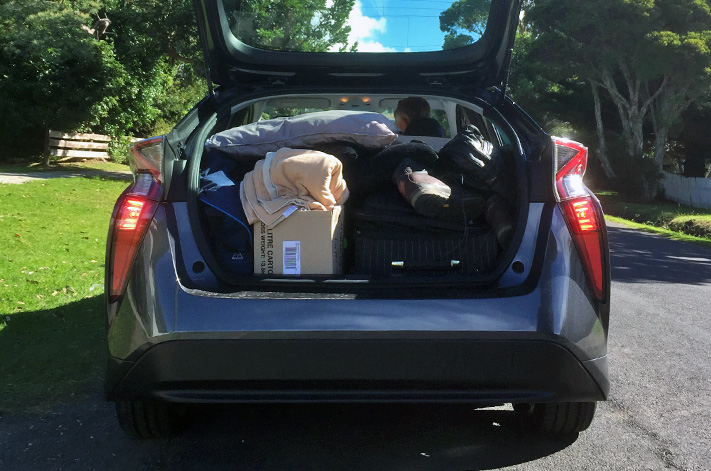
Update 2: Under the Cover of Piety
Our little Prius absolutely shatters stereotypes in this past month’s check in
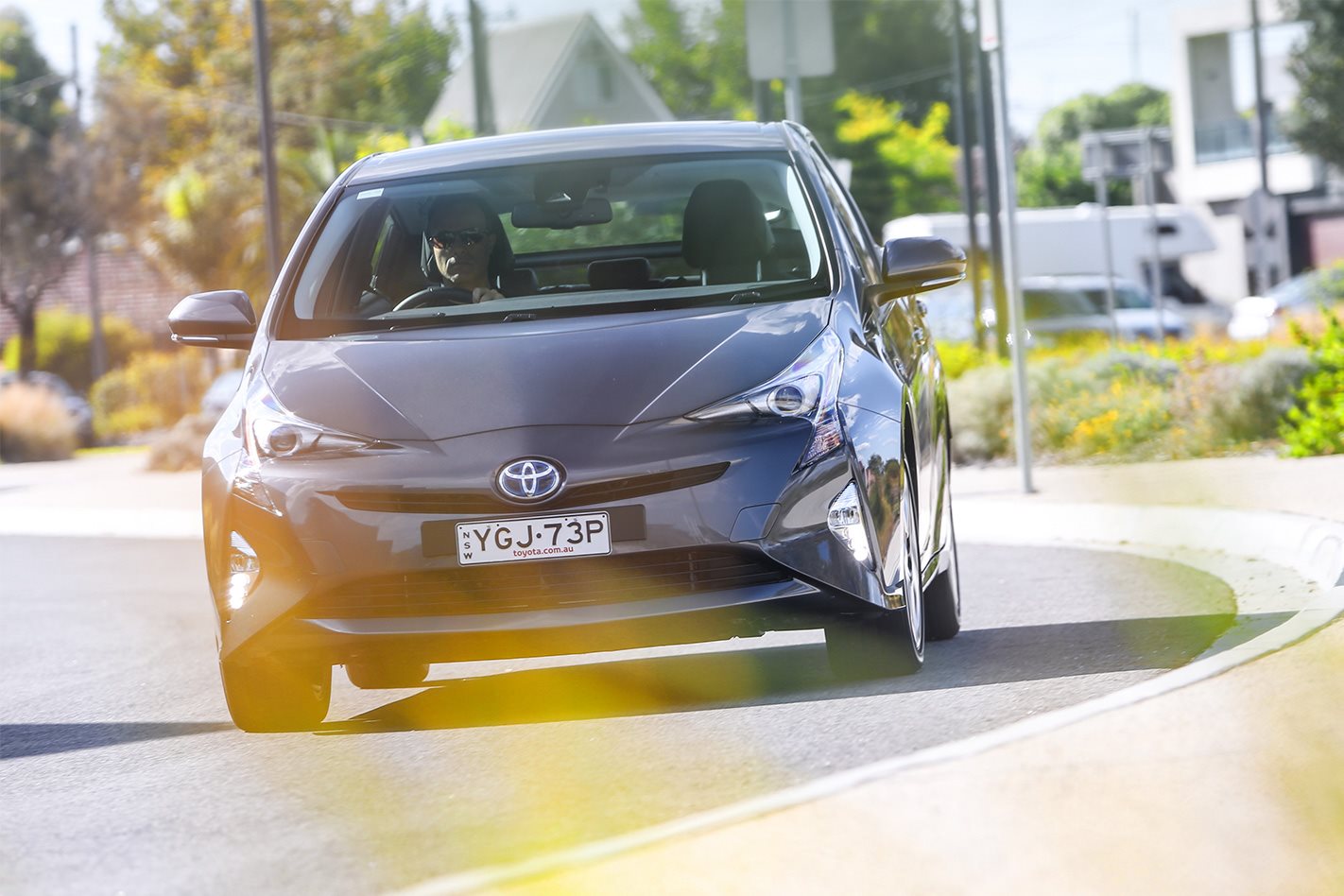
PIOUS. Enviro-wanker. Greenprius.
Okay, I made the last one up, but the first two are actual insults levelled at me, and even occasionally in relation to my Prius.
Well, you can add hoon too, to such not entirely unwarranted barbs. I am, after all, a cyclist and a vegetarian.
This month, in the middle of nowhere early one cold and dreary Sunday, the Toyota Prius and I bonded. Truly bonded. The very ribbon-like stretch of rural road was invitingly damp, bumpy and completely desolate for as far as the eye could see, so I went for it.
Hard, fast and furious, with the Sport Mode activated (oh, how comically horrible are the graphics!), the chassis’ response proved revelatory. At speed (and there’s plenty of it instantly if you’re willing to prod the pedal), the steering weights up nicely and reacts with a newfound sharpness. The front end tucks in naturally with pleasingly taut body control and little understeer. Actual fun. From a Toyota hybrid. Will wonders never cease?
Sure, the helm still feels artificial, there isn’t much driver involvement beyond pointing the wheel, and there’s no escaping some of that dreaded CVT-induced engine drone, but this gen Prius’s tidy handling, roadholding and ride comfort when pushed are totally unforeseen delights.
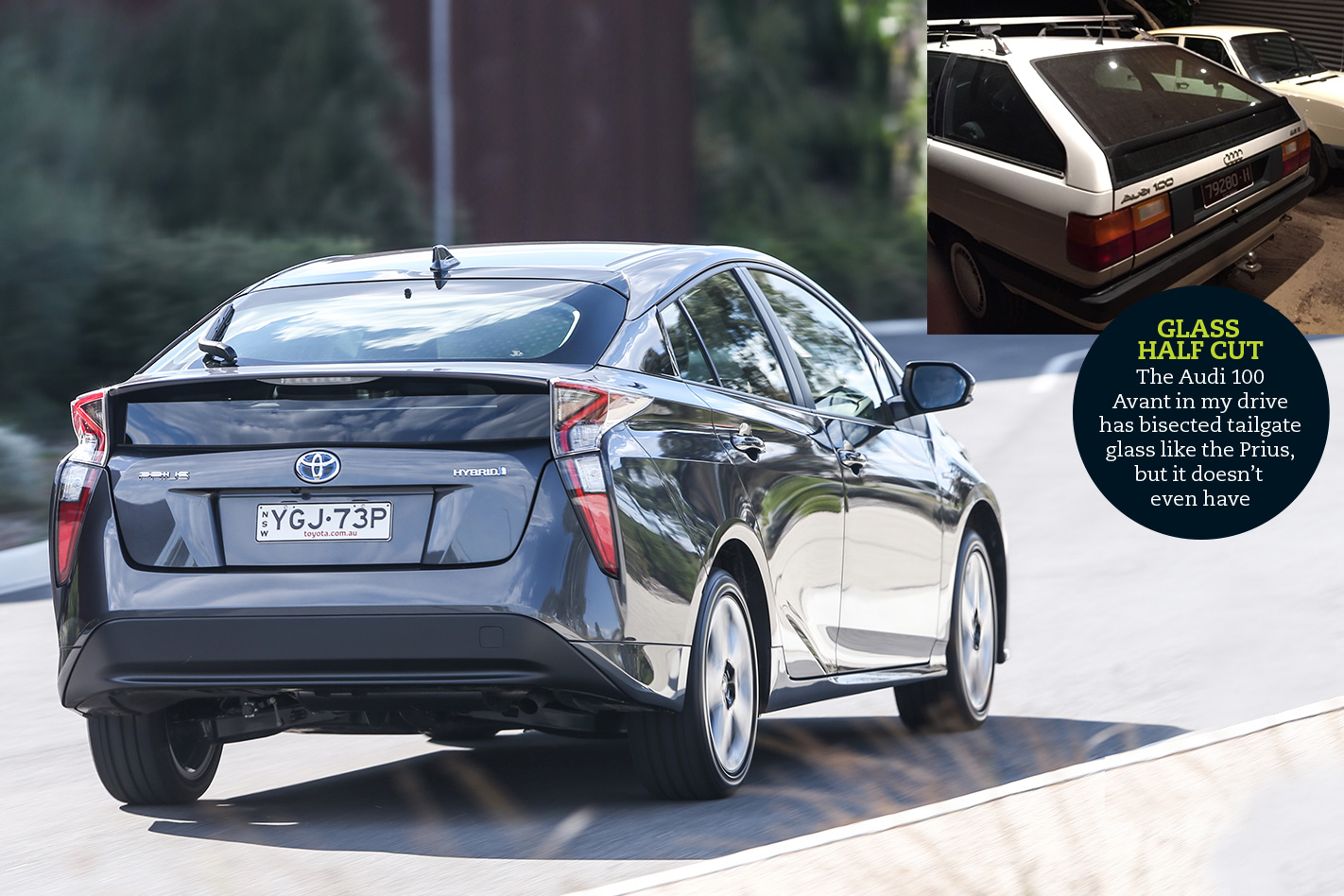
Underlining this was the hallowed company the Prius kept during that weekend away – my 1982 Alfa Romeo Alfasud Super. In convoy just because, the Italian model, which UK’s Car magazine dubbed the Car of the Seventies, showed just how far the Prius has progressed. While the Alfa’s incredible steering tactility and delicate control still beguile four decades on, the hybrid is like a 787 Dreamliner to the 1.5-litre boxer four’s Lockheed Constellation – slow, noisy and smelly.
If only the Toyota could infuse something approaching the Alfa’s visual charm. Admittedly, the profile and rear have grown on me and I even find delight in seeing the snaking LED tail-light strip stay on as I walk away at night. But its wilfully divisive nosecone must surely keep prospective buyers away.
Which is a shame because it is turning into a dynamic, enjoyable and – of course – extremely economical five-seater with ample boot space and practicality to go with its green credentials.
If detractors could see just how expertly the Prius can dance under duress, they might be less liberal with their labelling. Can you imagine how shocked some owners would be at the shenanigans their sanctimonious hybrid is capable of?
Kanpai, Toyota!
Update 3: Conclusion
After fourth months with the Prius, Byron has found real depth of ability under that divisive exterior
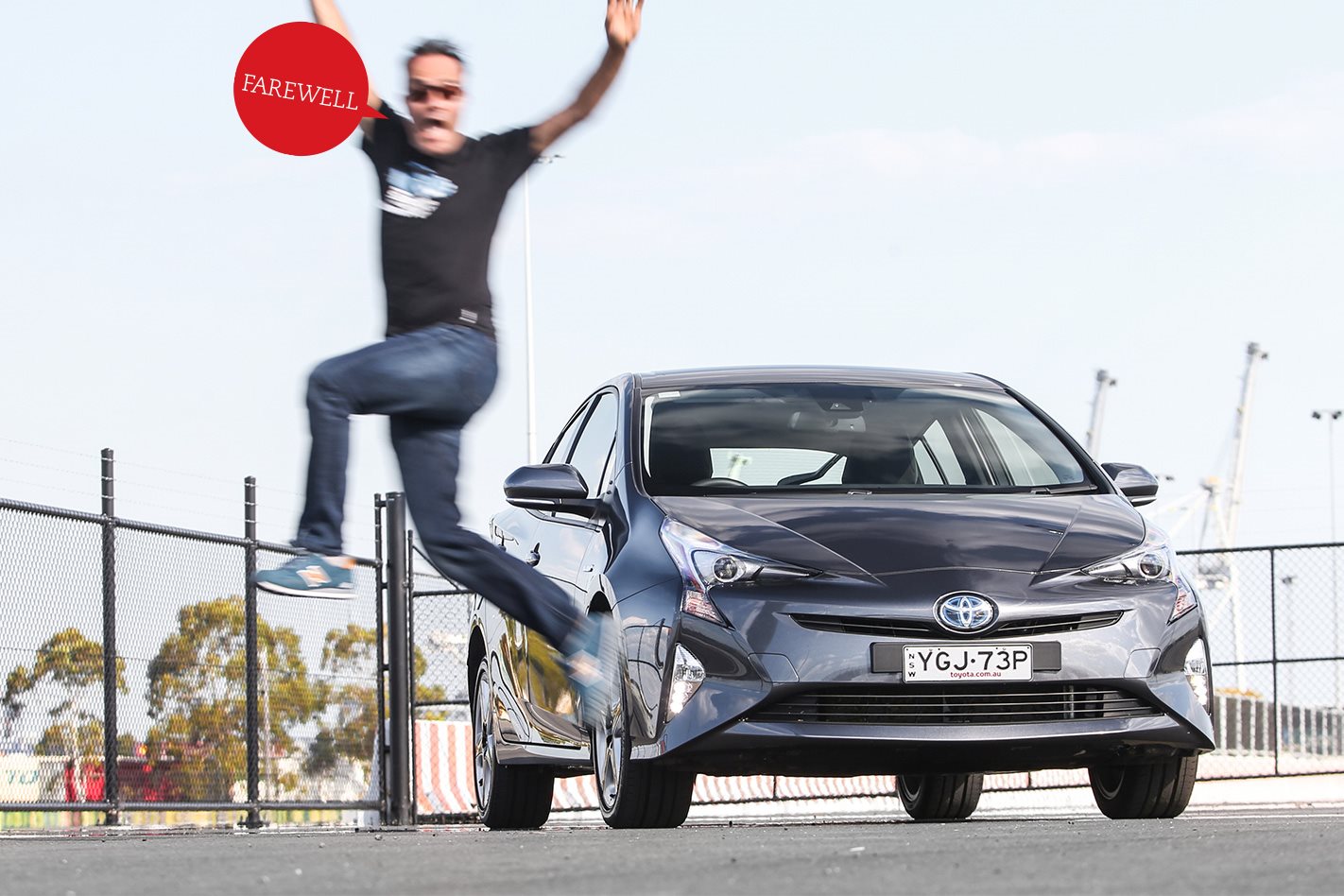
FOUR months in and nearly seven thousand kilometres on, it’s time for our Toyota Prius to check out. And, pun aside, what a shock this petrol-electric hybrid has been.
Intriguingly, YGJ-73P has had to live alongside an actual electric vehicle, my partner’s 2012 Nissan Leaf – a car with true zero tailpipe emissions. I wanted to ascertain how a petrol-electric series-parallel hybrid would seem against a real EV.
Ultimately, regarding the Prius as electric is like expecting an emu to fly.
Neither offers much range. The paltry 2km (at under 37km/h) in the Toyota Prius’ case barely registers, except in slow and heavy traffic, and when the internal-combustion engine does flare up, any EV smugness turns to smog.
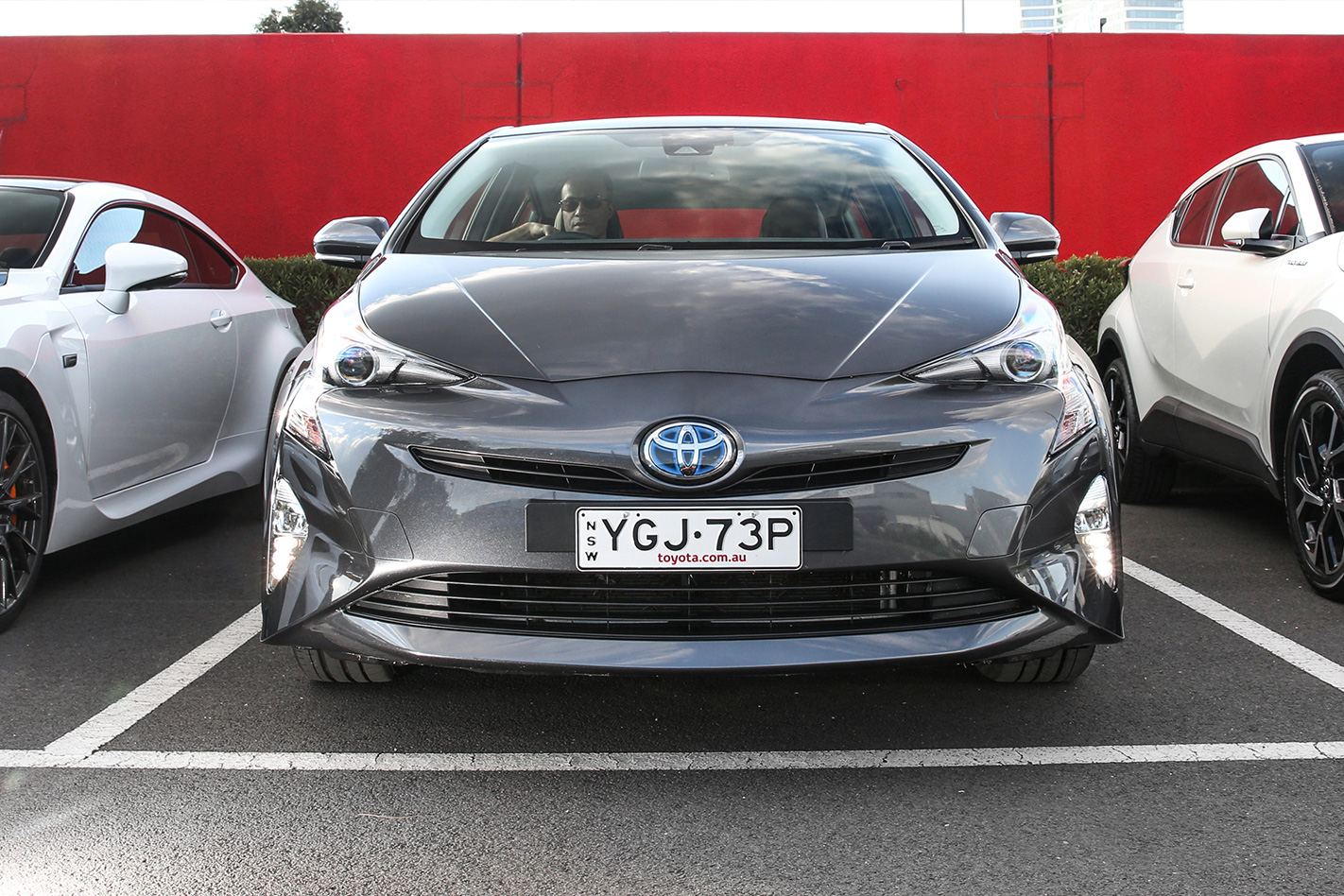
Far better then to focus on how the Toyota’s electricity enhances the experience instead. Such as with added acceleration; excellent real-world fuel consumption (4.8L/100km embarrasses most diesels); and regenerative braking that allows the driver to minimise efficiency-destroying and/or jerky braking with just a flick of the transmission lever across from ‘D’ to ‘B’. Brilliant.
However, while every Prius has managed all this since the 1997 original, where the box-fresh fourth-gen leaps ahead is in how much more driver orientated it is.
While not especially tactile, the steering is now eager and measured in its response; fast tight turns reveal a taut and controlled chassis that points precisely where directed; and the struts and wishbone suspension set-up soaks up bumps big and small like no previous iteration could. Keen drivers will find something here to dig.
And finally, there is the comfort and refinement. Larger inside than its diminutive hatchback dimensions suggest, the latest Prius offers room, practicality and peace akin to a midsizer, complete with a usefully long and deep boot.
Except for lower-than-normal rear-door apertures due to the sloping roofline, this is proper family car fare.
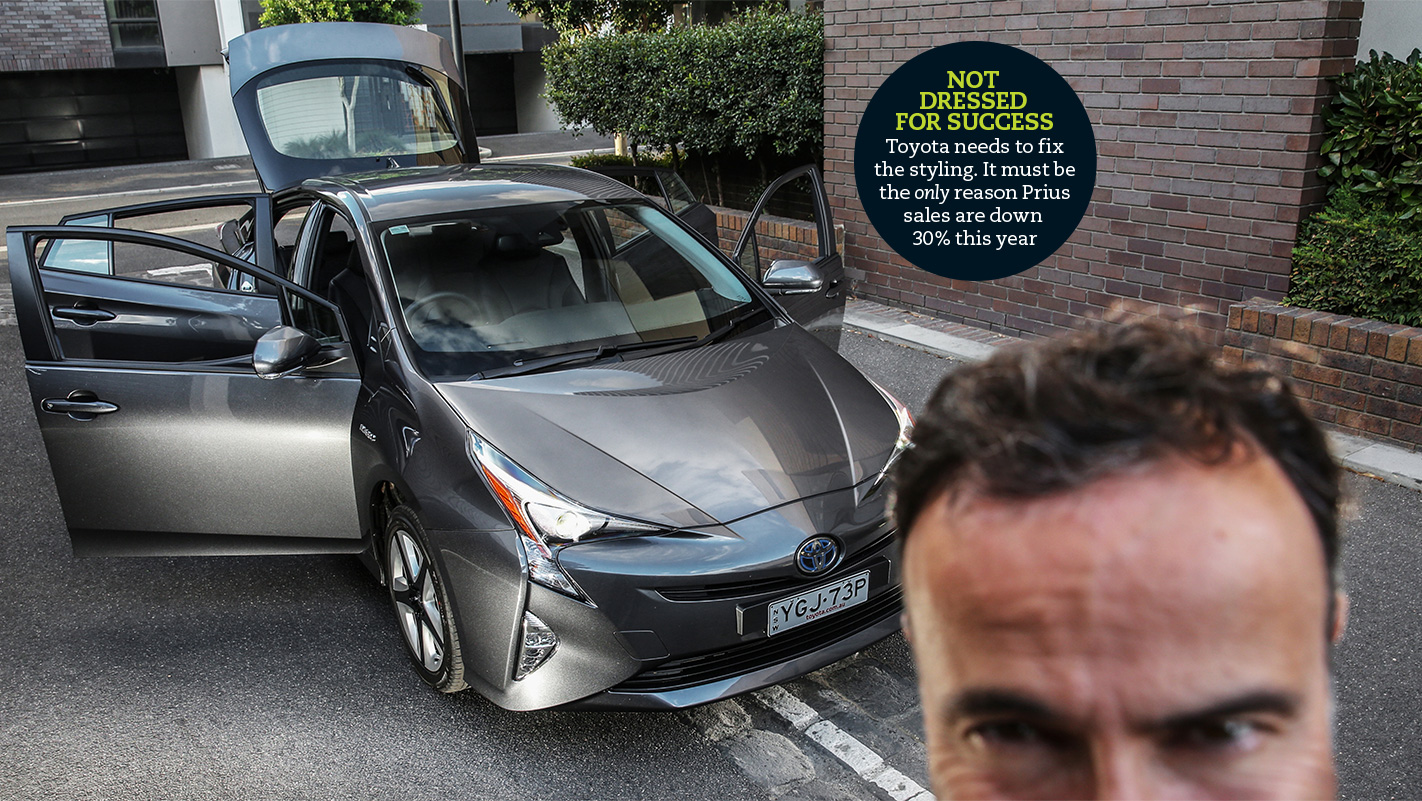
Disappointments? Few really, like the vision-impeding and filth-collecting bisected rear glass, busy instrument graphics, and fiddly park-brake pedal. But all this pales against the car’s crinkly styling, as though somebody slept on the original paper drawings. Pretty she ain’t.
Massively improved nonetheless, the latest Toyota hybrid is an interesting, enjoyable and effective alternative to any number of hatchbacks, sedans or SUVs under $50K.
One day soon fuel prices will rocket and the Prius’ time will arrive. When that happens rest assured that the car is finally ready.
But why wait until then to enjoy one?



